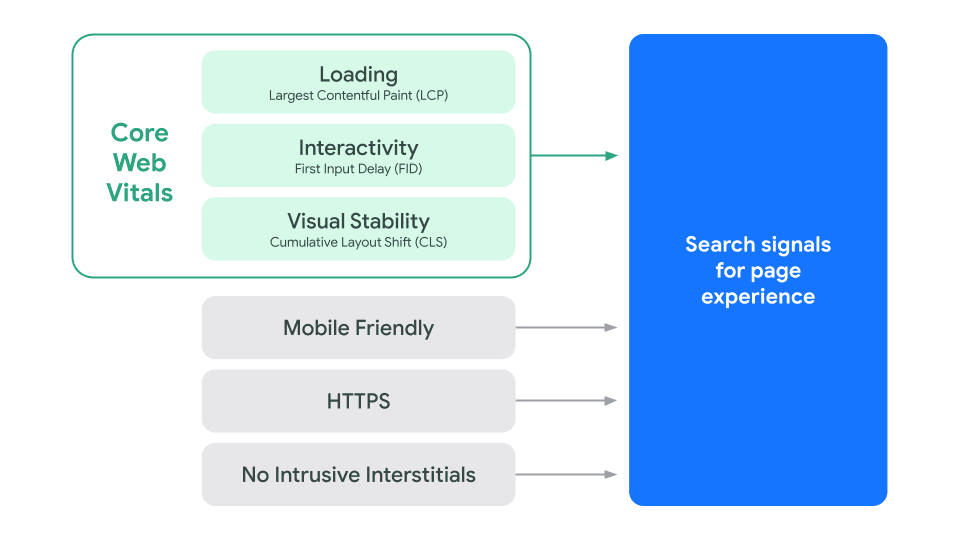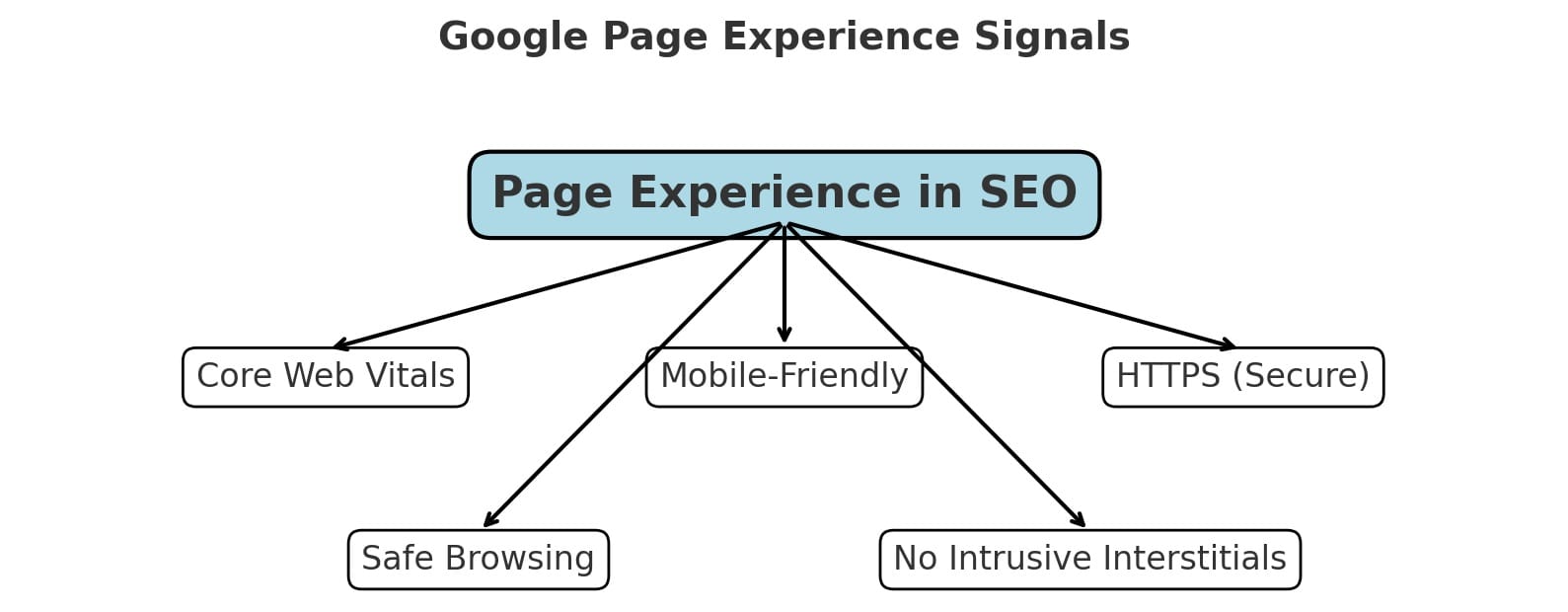In the ever-evolving landscape of digital marketing, understanding what is page experience in SEO is crucial. As search engines, especially Google, continue to refine their algorithms, the emphasis on delivering a superior user experience becomes more pronounced. Let’s explore the intricacies of page experience and how it fundamentally impacts search engine optimization.

What is Page Experience in SEO?
Page experience in SEO refers to a set of signals that measure how users perceive the experience of interacting with a web page beyond its pure informational value. These signals include several aspects of web usability, such as mobile-friendliness, safe browsing, HTTPS, and intrusive interstitial guidelines.
When we think about page experience, it’s about ensuring that visitors not only find the content they need but also enjoy a seamless, engaging interaction with the site. This involves optimizing various elements to ensure speed, responsiveness, and visual stability, creating a holistic online experience that meets or exceeds user expectations.
Page experience is not just a theoretical concept; it’s a tangible factor that search engines use to rank websites. As such, businesses must prioritize improving these aspects to remain competitive in search engine rankings. Understanding and optimizing page experience is crucial for anyone serious about boosting their online presence and ensuring long-term success.
The Core Web Vitals and Their Significance
Core Web Vitals are a set of specific factors that Google considers important in a webpage’s overall user experience. They consist of three main metrics: Largest Contentful Paint (LCP), First Input Delay (FID), and Cumulative Layout Shift (CLS). Each of these metrics offers insight into different aspects of a user’s interaction with a web page.
- Largest Contentful Paint (LCP): Measures loading performance. To provide a good user experience, LCP should occur within 2.5 seconds of when the page first starts loading.
- First Input Delay (FID): Measures interactivity. For a good user experience, pages should have an FID of less than 100 milliseconds.
- Cumulative Layout Shift (CLS): Measures visual stability. Pages should maintain a CLS of less than 0.1 for a good user experience.
These metrics are significant because they directly relate to how users perceive the speed and responsiveness of a site. Improving these elements not only boosts user satisfaction but also enhances search engine rankings, as Google prioritizes sites that offer superior user experiences.
Key Factors That Influence Page Experience
Several key factors influence page experience, each contributing to the overall perception and usability of a website. Understanding these elements helps in crafting a strategy for improvement.
- Mobile-Friendliness: With the increasing use of mobile devices for browsing, ensuring your site is mobile-friendly is paramount. This means your site should be responsive and easily navigable on smaller screens.
- Safe Browsing: Users need to feel secure when visiting a site. Implementing security measures such as HTTPS and avoiding harmful or misleading content is crucial for a positive page experience.
- Page Load Speed: A fast-loading page keeps users engaged and reduces bounce rates. Optimizing images, leveraging browser caching, and employing content delivery networks (CDNs) are effective strategies.
These factors are intertwined, and focusing on them collectively can significantly enhance the overall page experience. As we delve deeper, it’s clear that optimizing these areas not only helps in SEO but also builds trust and satisfaction among users.
How Page Experience Impacts SEO Rankings
The impact of page experience on SEO cannot be overstated. Search engines are designed to deliver the best possible results to users, and page experience is a critical component of this.
Google has explicitly stated that page experience is a ranking factor. Websites that deliver superior page experiences are more likely to rank higher in search results. This means that even if a site has excellent content, it could still be outranked by competitors offering a better user experience.
Moreover, a positive page experience can lead to longer visit durations, lower bounce rates, and higher conversion rates. These behavioral metrics signal to search engines that a site is valuable and worth promoting, further boosting its rankings. Understanding and optimizing page experience is, therefore, not just about compliance but about leveraging SEO for maximum impact.
Measuring Your Website’s Page Experience
Measuring your website’s page experience is a crucial step in understanding how well your site meets user expectations. Several tools and techniques can help assess these metrics.
- Google’s PageSpeed Insights: This tool provides detailed reports on the performance of your pages and suggestions for improvements. It evaluates both desktop and mobile versions, ensuring comprehensive insights.
- Lighthouse: An open-source, automated tool for improving the quality of web pages, Lighthouse provides audits for performance, accessibility, SEO, and more.
- Search Console’s Core Web Vitals Report: This report gives an overview of your site’s performance based on real-world usage data, offering a clear picture of how your pages perform in terms of Core Web Vitals.
By regularly measuring your website’s page experience, you can identify areas for improvement and track progress over time. This proactive approach ensures that your site remains competitive and aligned with user expectations and search engine requirements.

Improving Your Site’s Page Experience
Once you’ve measured your page experience, the next step is to implement improvements. This process involves optimizing various elements to enhance user satisfaction and boost SEO performance.
- Optimize Images and Videos: Large media files can slow down page load times. Use compression techniques and modern formats like WebP to reduce file sizes without compromising quality.
- Enhance Server Response Time: A slow server can bottleneck your page speed. Optimize server performance by selecting a reliable hosting provider and utilizing server-side caching.
- Minimize JavaScript and CSS: Excessive scripting can delay rendering. Minimize and defer non-essential JavaScript and CSS to enhance loading times.
Improving your site’s page experience is an ongoing process. By continually refining these elements, you not only improve user satisfaction but also ensure that your site remains competitive in the ever-changing SEO landscape.
The Role of Mobile-Friendliness in Page Experience
Mobile-friendliness plays a pivotal role in page experience, especially as mobile browsing continues to surpass desktop usage. A mobile-friendly site ensures that users on all devices can engage with your content effortlessly.
Responsive design is the cornerstone of mobile-friendliness. This involves creating web pages that automatically adjust to different screen sizes and orientations, ensuring a seamless experience regardless of device. A responsive design not only improves user satisfaction but also aligns with Google’s mobile-first indexing policy, which prioritizes mobile versions of content in search rankings.
Additionally, mobile-friendly sites should focus on touch-friendly navigation, fast loading times, and easy-to-read text. By prioritizing these elements, you can significantly enhance the mobile user experience, ultimately boosting your site’s SEO performance.
Best Practices for Enhancing Page Speed
Enhancing page speed is a critical aspect of improving page experience. Faster pages lead to better user engagement and higher search engine rankings. Here are some best practices to consider:
- Enable Compression: Use Gzip to reduce the size of your HTML, CSS, and JavaScript files.
- Leverage Browser Caching: Store static files in the user’s browser cache to reduce load times on subsequent visits.
- Use Content Delivery Networks (CDNs): CDNs distribute your content across multiple servers worldwide, ensuring faster delivery by reducing the physical distance between the server and the user.
By implementing these best practices, you can significantly improve page speed, enhancing the overall user experience and positively impacting SEO rankings. A faster site not only satisfies users but also aligns with search engine criteria for high-ranking pages.
Tools to Evaluate and Optimize Page Experience
Several tools can aid in evaluating and optimizing page experience, helping you achieve a competitive edge in SEO. These tools provide insights and actionable recommendations to enhance your site’s performance.
- Google PageSpeed Insights: Offers suggestions to improve your page speed by analyzing the content of a web page and generating tailored recommendations.
- GTmetrix: Provides a comprehensive analysis of page load time, helping identify performance bottlenecks and offering practical solutions.
- WebPageTest: Allows you to test the speed of your web pages from various locations worldwide, offering valuable insights into how your site performs on different networks.
Utilizing these tools can help you identify areas for improvement and track the impact of your optimization efforts. They are essential resources for anyone serious about optimizing page experience and enhancing their SEO strategy.
Why Page Experience Matters in SEO
- Better Rankings: While not the most dominant factor (content & relevance still lead), a good page experience can tip the scales in competitive niches.
- Higher Engagement: Users stay longer on sites that load fast and feel smooth.
- Lower Bounce Rate: Frustrated users leave slow or unstable pages quickly.
- More Conversions: Trust, ease of use, and speed encourage users to complete desired actions.
Conclusion: Emphasizing the Importance of Page Experience in SEO
In conclusion, understanding what is page experience in SEO is fundamental for anyone looking to excel in the digital space. Page experience encompasses various elements that collectively influence user satisfaction and search engine rankings. By focusing on core web vitals, mobile-friendliness, page speed, and safe browsing, you can craft an online presence that is both user-friendly and SEO-optimized.
The impact of page experience on SEO is profound. A well-optimized site not only ranks higher but also retains users and converts visitors into loyal customers. As search engines continue to prioritize user experience, investing in these enhancements becomes not just beneficial but necessary.
I encourage you to start evaluating and optimizing your page experience today. Utilize the tools and strategies discussed in this guide to ensure your website meets the highest standards. By doing so, you’ll not only improve your search engine rankings but also deliver an outstanding experience to your users.
Call to Action: Take a moment to assess your website’s page experience using the tools and tips provided in this guide. By investing in these improvements, you’ll set your site up for success in the competitive world of SEO. Let’s make your web presence not just a destination but an experience to remember.